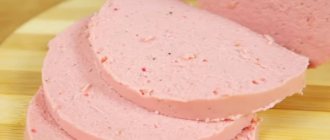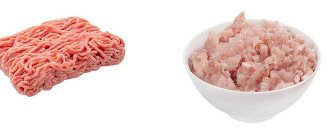How many calories are in sausages and what are sausages made of?
Manufacturers of semi-finished meat products like to give their products attractive names. There are “milk”, “crumb”, “dietary”, “creamy”, “doctor” sausages. Of course, the buyer, when purchasing sausages, believes that he is buying, if not healthy, then, in any case, not harmful products.
How are things really going? In fact, sausages contain 10-20, or at best 30%, meat. Moreover, this is not meat itself, but pork and chicken skin, lard, tendons, and cartilage tissue. All this is thoroughly crushed and whipped. Then, depending on the recipe, soy protein, gelatin, vegetable fiber, protein-fat emulsions, spices, flavor enhancers, and color stabilizers are added in different proportions. Whether such a “cocktail” can be useful is something everyone decides for themselves.
Now let's find out how many calories sausages contain . Despite the fact that there is very little meat in these products, the calorie content of sausages is high and always exceeds 200 kcal per 100 g of product.
Thus, chicken sausages have the lowest energy value. It is 200-250 kcal. Beef sausages contain more calories - 240-280 kcal. The calorie content of pork sausages is the highest and can reach 350 kcal. Amateur sausages also contain an impressive amount of calories (320-330), since they are prepared mainly from pork meat and lard.
For many years now, there has been a high demand for Russian sausages. Their energy value is 240-250 kcal.
Doctor's sausages are even more popular. The calorie content of sausages of this brand, like other types of sausages, largely depends on the manufacturer. On average, doctor's sausages contain approximately 240-250 calories . And Doctor’s sausages from the Cherkizovsky meat processing plant have the lowest energy value: 205 kcal.
On average, one sausage weighs 50 g. This is important for sausage lovers to know in order to keep the amount of calories they consume under control.
How many carbohydrates are in a sausage? Milk sausages
Milk sausages are a type of boiled sausage products made from meat with the addition of milk powder. Milk sausages are produced in a natural casing made of gelatin or animal intestines, light pink or pink-brown in color, medium thickness, in the form of long sausages. The taste of milk sausages is pleasant, with a slight aroma of smoke and milky aroma. The production of milk sausages is regulated by GOST R 52196-2011.
Calorie content of milk sausages
The calorie content of milk sausages is, on average, 266 kcal per 100 grams of product. Calorie content depends on the manufacturer and may vary.
Composition and beneficial properties of milk sausages
The product contains: pork, beef, milk powder, salt, egg powder, sugar, black and allspice, nutmeg (sometimes replaced with cardamom). Milk sausages contain easily digestible protein and are suitable for feeding children and the elderly.
Harm from dairy sausages
Sausages, like any boiled meat product, contain a lot of salt, which retains liquid and can lead to edema. Milk sausages can cause allergic reactions; people with lactose intolerance should use the product with caution.
Selection and storage of milk sausages
It is best to purchase milk sausages in vacuum or sealed packages made by a trusted manufacturer. The sausages must be the same size and uniform color, without whitish or dark spots, or drops of water on the casing. The shelf life of milk sausages indicated on the packages usually does not exceed 30 days (calorizator). Milk sausages should be stored in the refrigerator; they can be frozen to extend their shelf life.
Dairy sausages in cooking
Dairy sausages must be heat treated; they are boiled, fried, or grilled. Milk sausages can be added to meat soup, stewed vegetables, scrambled eggs and omelettes, and pizza. A traditional side dish for milk sausages is boiled pasta, mashed potatoes or fresh vegetable salad. Sausages in dough are a quick and budget-friendly dish for feeding unplanned guests. Some housewives prepare Olivier salad with sausages.
For more information about milk sausages, see Copying this article in whole or in part is prohibited.
Calorie content of milk sausages
Milk sausages are one of the most beloved and readily purchased. But don’t delude yourself by imagining that they are made from suckling pig or calf meat. Regular pork and beef are used to produce sausages. And the sausages owe their name to the fact that they contain milk powder. It gives the sausages a delicate taste with a creamy tint. The calorie content of milk sausages ranges from 240 to 268 kcal. Moreover, most of the energy value (approximately 215-220 kcal) is provided by fats.
The calorie content of milk sausages can vary, sometimes significantly, depending on the manufacturer.
About sausages:
In the modern world, we are accustomed to experiencing a lack of time. Therefore, sometimes it is very important to quickly prepare your own food. And here we need dishes that do not require much time to prepare. Such, for example, as sausages. Sausages are a common and popular dish that includes minced meat - animal or poultry. There are a great many different types of sausages.
This dish includes various additives, which affects both the taste of the sausages and the number of calories in them. Therefore, when we hear the question - how many calories are in a sausage? – you must remember that the calorie content for each type of sausage is different.
The main feature of sausages is that there is little need for their preparation, such as frying on the grill or frying pan or boiling. Today, sausages are made mainly from the meat of several types of animals. It is basically a mixture of beef and pork. Sometimes chicken can also be used. Sausages today are familiar and familiar to everyone; they can be found in almost every kitchen. But precisely because of their popularity, many of us are worried about the question - what is the calorie content of sausages?
In general, this question can be answered: the calorie content of an average sausage ranges approximately from 288 to 320 kcal per 100 grams. product. How can sausages be useful? Probably because with their help we can quickly get enough.
The benefit of sausages lies in the fact that, having a significant calorie content, they are able to well compensate for the body’s energy costs. But only good sausages.
Sausages of dubious quality will only do harm. Due to the fact that significant deviations from GOST standards have been observed more and more recently, sausages may contain meat trimmings: tendons, skin and bones, as well as soy, chemical additives, flour, animal blood and fat, cereals, flavorings , dyes, thickeners, and flavor enhancers. Some of the substances that make up sausages can provoke severe allergic reactions, especially for children. In addition, flavor enhancers are addictive, which can result in a person losing the ability to enjoy the natural taste of healthy food.
Calorie content of sausages and dietary nutrition
Among the prohibitions of most diets, the ban on fast food and processed foods is the strictest. And sausages belong specifically to semi-finished products, however, they can also be classified as fast food products. We know that during diets aimed at weight loss, preference is given to low-calorie products, that is, those whose energy value does not exceed 100 kcal per 100 g of product. Sausages do not meet these requirements. After all, the calorie content of sausages, in any case, exceeds 200 kcal .
In addition, when dieting, it is advisable to use natural products to allow the body to cleanse itself of metabolic products and toxins from food. And we know for sure that chemical food additives are always used in the production of sausages. Thus, sausages are not considered a dietary product. However, if you do not eat them constantly, but only from time to time, say, once a week, then they will not cause damage to your health and will not be able to harm your figure.
Mashed potatoes with sausage calories. Why do we eat sausages, calorie content
The popularity of sausages is beyond doubt - these simple semi-finished products have long been widely used in cooking both as “quick” dishes and as a basis for complex and tasty dishes. They are a real lifesaver for busy people who don’t have time to prepare a meat or vegetable dish for dinner or lunch. Many mothers use sausages to feed their children, as children love them very much, although this is not the healthiest product for feeding children.
The main difference between sausages and other sausages is that they are eaten after heat treatment - boiling, stewing, frying or grilling. The quality varies - the cheapest, and, as a rule, low-quality ones contain very little minced meat and many additives such as vegetable protein (soy), starch, flavoring and aromatic additives, preservatives, etc. It’s easy to guess that such sausages are not the most desirable food. The higher the meat content, the better the taste, the higher the quality and the more benefits for the body. GOST standards adopted in the USSR allowed the meat content in sausages to be at least 50%. Nowadays, production often uses not GOST standards, but technical specifications (TU), which, unfortunately, allow for a lower meat content (10% or even less).
The calorie content also depends on the composition, although on average it remains at the level of 300 kcal per 100 g. Chicken sausages contain fewer calories than pork or beef. Sausages with soy protein may have fewer calories, but not everyone approves of soy products. Some of the most popular types of sausages are “Dairy” and “Bavarian”; smoked varieties (for example, Munich or hunting) are also in demand.
Regular sausages can hardly be called a dietary dish, but no one disputes the fact that they are indeed very popular because of their taste, as well as ease of preparation. They can quickly satisfy your hunger - after all, the calorie content of sausages is really very high, since they contain a lot of fat. Everyone likes the taste, although few people think that they owe their taste not to meat, but to various additives - salt, spices, flavor enhancers, preservatives, flavorings. Sausages are very easy to cook - just boil them in water, so they are popular among those who do not have time for long cooking. Ease of preparation, high calorie content and the ability to quickly satisfy hunger at a relatively low price are one of the reasons for the popularity of sausages in school and university canteens.
However, nutritionists do not have a very high opinion of these sausages - as a rule, rather low-grade meat is used in their production (sinews, fat, tendons, intestines, joints and other not the most edible parts of the meat carcass). In addition, the composition includes many accompanying additives that are included in the formulation in order to increase the mass of the final product, but do not provide any benefit to the body and may even be harmful (such as saltpeter). Therefore, sausages are not recommended for consumption by children, pregnant or lactating women, as well as people with diseases of internal organs, gastrointestinal tract, liver, kidneys, biliary tract, thyroid gland (due to the content of preservatives, dyes, flavor enhancers and other chemical compounds), as well as diabetes (due to the high glycemic index of sausages) and obesity (due to the high calorie content of sausages). Also, do not forget that sausages contain cholesterol, which does not have the best effect on the functioning of the cardiovascular system.
Calorie content of sausages in dough
This is one of the favorite fast food treats. A sausage in dough and a glass of sweet coffee or tea (or a mug of beer) is a favorite option for a “snack” for working people or students. If you eat like this all the time, then you will have to forget about being slim over time. After all, on average, the calorie content of sausage in dough is 350-370 kcal per 100 g.
The energy value of a pie filled with sausage can vary significantly, depending on what kind of sausages were taken and what type of dough was used. Most often, bread or butter yeast dough is used. In the first case, the calorie content of the dough is lower, therefore, the energy value of the finished product will be less. The calorie content of sausages in the dough will be less if they are baked in the oven rather than fried in oil in a frying pan. In this case, the calories contained in the oil, which is absorbed by the dough during frying, should be added to the calorie content of the sausage and dough.
Puff pastry is less commonly used to make sausages in dough. In this case, the pies turn out to be extremely high in calories - up to 400 kcal. Since puff pastry itself is very fatty, sausages in puff pastry are never fried, but only baked in the oven.
It is very difficult to say what the calorie content of one sausage in the dough is, because each catering establishment has its own standard, and the pies have different weights.
By the way, the famous hot dog can also rightfully be considered a type of sausage in dough. The only difference is that for its preparation, not dough is used, but a ready-made bun - baguette, and mustard, ketchup and mayonnaise are added. In terms of caloric content, a sausage in dough and a hot dog are approximately equal .
Number of calories in main types of sausages
As already mentioned, sausages are made in different ways and from different types of meat. Before you understand, for example, how many calories are in one butter sausage, it is worth knowing that, in addition to meat, it contains cream, which is not considered a low-calorie product. The calorie content of such a sausage is approximately 260 kcal per 100 grams of product, and given that the average weight of a sausage is 50-60 grams, one product contains approximately 130 kcal. If we talk about dairy additives, then it is worth paying attention to how many calories are in one sausage with cheese, during the production of which less fatty cheese is added to the minced meat. The calorie content of such sausages is 245 kcal per 100 grams.
When talking about sausages as a dietary product, we often mean how many calories are contained in one chicken sausage, which is considered lower in calories than a sausage made from minced beef. A chicken sausage contains approximately 200-220 kcal per 100 grams of product, and those who are interested in how many calories are in one beef sausage should know that the benefits of such sausages are less, since their calorie content increases to 250 kcal per 100 grams. And you certainly won’t be able to lose weight by eating sausages cooked in batter. If you want to lose weight and find out how many calories are in one sausage in the dough, you will definitely give it up, since the number of calories reaches 300 kcal or even more.
Whatever sausages you choose, remember that they must be fresh, because in addition to excess weight, you can earn a whole “bouquet” of diseases. You should be wary of products with bright colors, and the freshness of the sausage will be indicated by the fact that, when pressed, it will quickly return to its original state. The absence of fat stains will also indicate the quality of the sausages, and do not forget to look at the expiration date, because poisoning with meat products can lead to serious consequences.
Sausages are finely ground minced meat, from which small-sized boiled sausages are made. There are many varieties of sausages, differing from each other in minced meat and cooking recipe. Therefore, some sausages are even used in dietary and baby food. Others containing a large amount of herbs, fat and spices are allowed to be consumed only by adults.
Calories in sausage
The calorie content of a sausage depends on the meat that underlies it, on the recipe and various additives. On average, the calorie content of 1 sausage is 112 - 172 kcal. The average weight of a sausage is approximately 50 grams. Chicken sausage has the lowest energy value; it ranges from 100 to 125 kcal per piece. In beef sausages this figure increases from 120 to 140 kcal. Pork sausages are the highest in calories and reach 172 kcal per piece.
Calorie content of milk sausages
Milk sausages are quite common in the diet of many people. The meat of animals or birds is thoroughly ground, after boiling and adding to dry low-fat milk.
Milk sausages are relatively high in calories. There are 266 kcal per 100 g of product, respectively, there are 133 calories in one sausage. These sausages are healthy due to their high content of the PP group - as much as 23%. They also contain phosphorus in the amount of 19.9% and sodium – 62.1%.
Today, there are many unscrupulous sausage manufacturers who, instead of traditional recipes, use a lot of harmful additives, flavor enhancers and acidity regulators in their sausages. A person who is on a diet will undoubtedly pay attention to how many calories are in sausage and how many are in meat. And at first glance it may seem that sausages will lead to the desired weight loss, but this is not so. The harm of dairy sausages lies not in calories, but in soy protein and starch, which are increasingly found in modern sausages.
Calorie content of sausage in dough
Sausage in dough is tasty, quick and convenient. But is it good for the body and figure? Regular consumption of sausage in dough will not go unnoticed. Per 100 g of product there is an average of up to 370 kcal. More accurate data depends on the sausage and the type of dough. Most often they use bread, butter yeast, or puff pastry. The calorie content of sausage in dough cooked in the oven will be lower than fried in a frying pan. Sausages in puff pastry break records for calorie content and reach 400 kcal per 100 g of product.
Jun-27-2014
— Is it true that the more expensive the sausages, the better they are?
A high price, as you know, does not guarantee quality!
This should be remembered when choosing any food products. But a too low price should also suggest that the manufacturer uses cheap raw materials to make sausages and, most likely, introduces additives prohibited by GOST to create the necessary taste and consistency.
Eating such a product will clearly not bring health benefits, so save wisely!
And now that you know what milk sausages are made of and how to choose them correctly, we offer several interesting recipes using this product.









